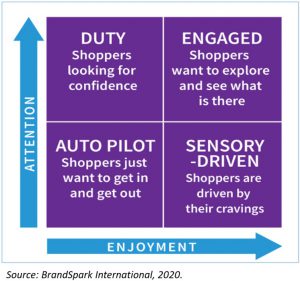Understanding the omni-channel path to purchase – and how to influence shoppers as they navigate through it – is a critical factor in driving marketing success. To do so effectively, a strong foundation to start with is what we call the BrandSpark Engagement Map, which is based on responses from over 80,000 North American consumers. My colleague Mark Baltazar explains this in a white paper you can download here .
The core model is a 2×2 – one of our favorite analytical tools – which reveals how shoppers engage with different categories based on two key factors. The first is attention, which captures how diligently they explore product features and benefits when making a purchase decision. The second is enjoyment, or simply how much they like shopping for that category.
The combination of these two factors creates four distinct quadrants, each of which represents a different shopper mindset – which leads to different marketing strategies and tactics required to be effective, particularly when launching new products (See Figure 1.).
Figure 1. The BrandSpark Shopper Engagement Map

For example, the “auto-pilot” shopper will be more likely than others to simply stick with their default – if it ain’t broke, don’t fix it. Trying to break through this malaise and stimulate trial for a new product is difficult, so disruptive tactics and very steep discounts/ free trials may be required to capture this group’s attention. In contrast, those in the “sensory-driven” mindset are much easier to win over, and willing to “trust their gut” if given any excuse to try something new. Meanwhile, those in the “engaged” mindset may be willing to switch – but will need lots and lots of proof, and are generally willing to sift through it all to ensure they are making the right decision.
Of course, the overall framework is just the start. BrandSpark uses in-the-moment shopper research to more acutely understand shopper mindset and how it’s impacting their decisions, as well as looking at mindset by shopper segment – as different shoppers engage with categories in different ways. Feel free to reach out if you like to learn more about how we can use to the Shopper Mindset model to help fine-tune your marketing strategies and tactics.

